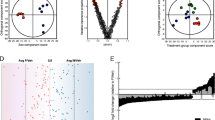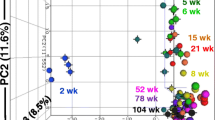Abstract
Many studies have focused on environmental estrogen-related diseases. However, no consistent gene markers or signatures for estrogenicity have been discovered in mammals. This study investigated the estrogenic effects of 17β-estradiol on the prostate in immature male mice. Consistent U-shaped responses were seen in bodyweight, ventral prostate epithelial morphology, and miRNA expression levels. Specifically, most estradiol regulated miRNAs were downregulated at low doses of estradiol (0.2 and 2 mg·kg–1), and whose expression returned to the control level at a larger dose (200 mg·kg–1). The function of these regulated miRNAs is related to the prostate cancer and PI3K-Akt signaling pathways, which is consistent with the function of estradiol. Furthermore, the miRNA-processing machinery, Drosha, in the prostate was also regulated in a similar pattern, which could be a part of the U-shaped miRNA expression mechanism. All of these data indicate that the prostate is a reliable organ for evaluating estrogenic activity and that the typical nonmonotonic dose-response relationship could be used as a novel biomarker for estrogenicity.

Similar content being viewed by others
References
Kerdivel G, Habauzit D, Pakdel F. Assessment and molecular actions of endocrine-disrupting chemicals that interfere with estrogen receptor pathways. International Journal of Endocrinology, 2013, 2013: 501851
Pelekanou V, Leclercq G. Recent insights into the effect of natural and environmental estrogens on mammary development and carcinogenesis. The International Journal of Developmental Biology, 2011, 55(7-8-9): 869–878
Shang G, Xue J, Li M, Hu H Y, Lu Y. Estrogen receptor affinity chromatography: a new method for characterization of novel estrogenic disinfection by-products. Chemosphere, 2014, 104: 251–257
Li M, Xu B, Liungai Z, Hu H Y, Chen C, Qiao J, Lu Y. The removal of estrogenic activity with UV/chlorine technology and identification of novel estrogenic disinfection by-products. Journal of Hazardous Materials, 2016, 307: 119–126
Williams G P. The role of oestrogen in the pathogenesis of obesity, type 2 diabetes, breast cancer and prostate disease. European Journal of Cancer Prevention, 2010, 19(4): 256–271
Burns K A, Korach K S. Estrogen receptors and human disease: an update. Archives of Toxicology, 2012, 86(10): 1491–1504
vomSaal F S, Timms B G, Montano M M, Palanza P, Thayer K A, Nagel S C, Dhar M D, Ganjam V K, Parmigiani S, Welshons W V. Prostate enlargement in mice due to fetal exposure to low doses of estradiol or diethylstilbestrol and opposite effects at high doses. Proceedings of the National Academy of Sciences of the United States of America, 1997, 94(5): 2056–2061
Timms B G, Howdeshell K L, Barton L, Bradley S, Richter C A, vomSaal F S. Estrogenic chemicals in plastic and oral contraceptives disrupt development of the fetal mouse prostate and urethra. Proceedings of the National Academy of Sciences of the United States of America, 2005, 102(19): 7014–7019
Nelson W G, DeMarzo A M, Yegnasubramanian S. The diet as a cause of human prostate cancer. In: Zappia V, Panico S, Russo GL, Budillon A, DellaRagione F, eds. Advances in Nutrition and Cancer. Cancer Treatment and Research. Berlin: Springer Berlin Heidelberg, 2014, 159:51–68
Sugimura Y, Cunha G R, Donjacour A A. Morphogenesis of ductal networks in the mouse prostate. Biology of Reproduction, 1986, 34 (5): 961–971
Jarred R A, McPherson S J, Bianco J J, Couse J F, Korach K S, Risbridger G P. Prostate phenotypes in estrogen-modulated transgenic mice. Trends in Endocrinology and Metabolism, 2002, 13 (4): 163–168
Hewitt S C, Deroo B J, Hansen K, Collins J, Grissom S, Afshari C A, Korach K S. Estrogen receptor-dependent genomic responses in the uterus mirror the biphasic physiological response to estrogen. Molecular Endocrinology (Baltimore, Md.), 2003, 17(10): 2070–2083
Watanabe H, Suzuki A, Kobayashi M, Takahashi E, Itamoto M, Lubahn D B, Handa H, Iguchi T. Analysis of temporal changes in the expression of estrogen-regulated genes in the uterus. Journal of Molecular Endocrinology, 2003, 30(3): 347–358
Hong S H, Nah H Y, Lee J Y, Gye M C, Kim C H, Kim M K. Analysis of estrogen-regulated genes in mouse uterus using cDNA microarray and laser capture microdissection. Journal of Endocrinology, 2004, 181(1): 157–167
An B S, Choi K C, Kang S K, Hwang W S, Jeung E B. Novel Calbindin-D(9k) protein as a useful biomarker for environmental estrogenic compounds in the uterus of immature rats. Reproductive Toxicology (Elmsford, N.Y.), 2003, 17(3): 311–319
Calin G A, Croce C M. MicroRNA signatures in human cancers. Nature Reviews, Cancer, 2006, 6(11): 857–866
Ha M, Kim V N. Regulation of microRNA biogenesis. Nature Reviews, Molecular Cell Biology, 2014, 15(8): 509–524
Witwer K W. Circulating microRNA biomarker studies: pitfalls and potential solutions. Clinical Chemistry, 2015, 61(1): 56–63
Gore AC, Chappell VA, Fenton SE, Flaws JA, Nadal A, Prins GS, Toppari J, Zoeller RT. EDC-2: the endocrine society’s second scientific statement on endocrine-disrupting chemicals. Endocrine Reviews, 2015, 36(6): E1–E150
Vlachos I S, Kostoulas N, Vergoulis T, Georgakilas G, Reczko M, Maragkakis M, Paraskevopoulou M D, Prionidis K, Dalamagas T, Hatzigeorgiou A G. DIANA miRPath v.2.0: investigating the combinatorial effect of microRNAs in pathways. Nucleic Acids Research, 2012, 40(Web Server issueW1): W498–W504
Lee Y R, Park J, Yu H N, Kim J S, Youn H J, Jung S H. Upregulation of PI3K/Akt signaling by 17beta-estradiol through activation of estrogen receptor-alpha, but not estrogen receptorbeta, and stimulates cell growth in breast cancer cells. Biochemical and Biophysical Research Communications, 2005, 336(4): 1221–1226
Guo R X, Wei L H, Tu Z, Sun P M, Wang J L, Zhao D, Li X P, Tang J M. 17 beta-estradiol activates PI3K/Akt signaling pathway by estrogen receptor (ER)-dependent and ER-independent mechanisms in endometrial cancer cells. Journal of Steroid Biochemistry and Molecular Biology, 2006, 99(1): 9–18
Hua K, Feng W, Cao Q, Zhou X, Lu X, Feng Y. Estrogen and progestin regulate metastasis through the PI3K/AKT pathway in human ovarian cancer. International Journal of Oncology, 2008, 33 (5): 959–967
Sosa L, Gutiérrez S, Petiti J P, Palmeri C M, Mascanfroni I D, Soaje M, De Paul A L, Torres A I. 17β-Estradiol modulates the prolactin secretion induced by TRH through membrane estrogen receptors via PI3K/Akt in female rat anterior pituitary cell culture. American Journal of Physiology-Endocrinology and Metabolism, 2012, 302(10): E1189–E1197
Li Z, Yang S, Liu S. Estrogen protects MIN6 beta-cell from hypoxic cell death via PI3K/Aktpathway. Diabetes, 2013, 62(suppl. 1): A562–A562
Marker P C, Donjacour A A, Dahiya R, Cunha G R. Hormonal, cellular, and molecular control of prostatic development. Developmental Biology, 2003, 253(2): 165–174
Huang L, Pu Y, Hu WY, Birch L, Luccio-Camelo D, Yamaguchi T, Prins G S. The role of Wnt5a in prostate gland development. Developmental Biology, 2009, 328(2): 188–199
Klinge C M. Estrogen receptor interaction with co-activators and corepressors. Steroids, 2000, 65(5): 227–251
Amara J F, Dannies P S. 17 beta-Estradiol has a biphasic effect on gh cell growth. Endocrinology, 1983, 112(3): 1141–1143
Taylor J A, Grady L H, Engler K S, Welshons W V. Relationship of growth stimulated by lithium, estradiol, and EGF to phospholipase C activity in MCF-7 human breast cancer cells. Breast Cancer Research and Treatment, 1995, 34(3): 265–277
Wetherill Y B, Petre C E, Monk K R, Puga A, Knudsen K E. The xenoestrogenbisphenol A induces inappropriate androgen receptor activation and mitogenesis in prostatic adenocarcinoma cells. Molecular Cancer Therapeutics, 2002, 1(7): 515–524
Alworth L C, Howdeshell K L, Ruhlen R L, Day J K, Lubahn D B, Huang T H M, Besch-Williford C L, vomSaal F S. Uterine responsiveness to estradiol and DNA methylation are altered by fetal exposure to diethylstilbestrol and methoxychlor in CD-1 mice: effects of low versus high doses. Toxicology and Applied Pharmacology, 2002, 183(1): 10–22
Welshons W V, Thayer K A, Judy B M, Taylor J A, Curran E M, vomSaal F S. Large effects from small exposures. I. Mechanisms for endocrine-disrupting chemicals with estrogenic activity. Environmental Health Perspectives, 2003, 111(8): 994–1006
Chen T. The role of MicroRNA in chemical carcinogenesis. Journal of Environmental Science and Health. Part C, Environmental Carcinogenesis & Ecotoxicology Reviews, 2010, 28(2): 89–124
Amiel J, de Pontual L, Henrion-Caude A. miRNA, development and disease. Advances in Genetics, 2012, 80: 1–36
Klinge C M. miRNAs and estrogen action. Trends in Endocrinology and Metabolism, 2012, 23(5): 223–233
Nothnick W B, Healy C. Estrogen induces distinct patterns of microRNA expression within the mouse uterus. Reproductive Sciences (Thousand Oaks, Calif.), 2010, 17(11): 987–994
Hou L, Lu Y, Li Y, Li L. MiRNA-451 is a potential biomarker for estrogenicity in mouse uterus. Frontiers of Environmental Science & Engineering, 2014, 8(1): 99–105
Moggs J G, Tinwell H, Spurway T, Chang H S, Pate I, Lim F L, Moore D J, Soames A, Stuckey R, Currie R, Zhu T, Kimber I, Ashby J, Orphanides G. Phenotypic anchoring of gene expression changes during estrogen-induced uterine growth. Environmental Health Perspectives, 2004, 112(16): 1589–1606
Author information
Authors and Affiliations
Corresponding author
Electronic supplementary material
Rights and permissions
About this article
Cite this article
Duan, R., Lu, Y., Hou, L. et al. U-shaped microRNA expression pattern could be a new concept biomarker for environmental estrogen. Front. Environ. Sci. Eng. 10, 11 (2016). https://doi.org/10.1007/s11783-016-0880-8
Received:
Revised:
Accepted:
Published:
DOI: https://doi.org/10.1007/s11783-016-0880-8




